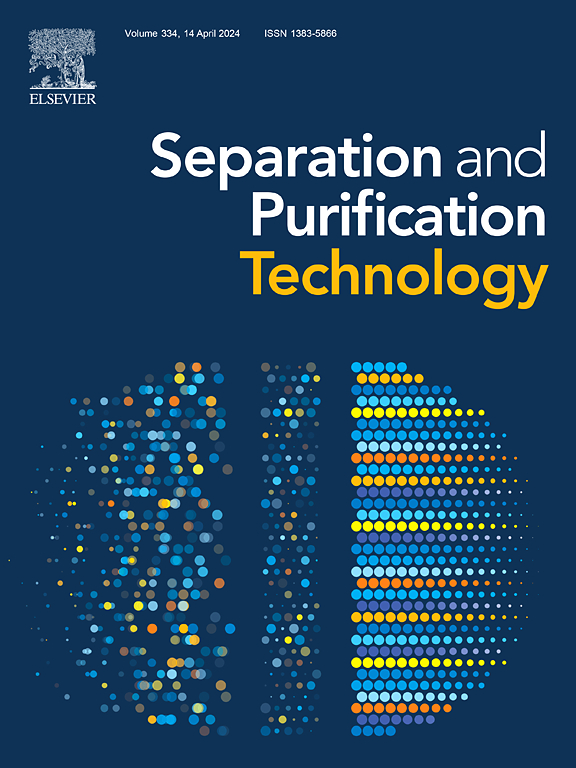MXene-based composites for adsorption and photocatalytic immobilization of U(VI): Current progress and future perspectives
IF 8.1
1区 工程技术
Q1 ENGINEERING, CHEMICAL
引用次数: 0
Abstract
Nuclear energy is widely noted for stable power, low carbon, high energy density and cost-effectiveness. Uranium plays an important role as one of the most commonly utilized elements in nuclear energy. Nevertheless, the efficient immobilization (extraction from seawater and removal from wastewater) of uranium is still a significant challenge. Emerging as a novel class of two-dimensional materials, MXenes demonstrate exceptional potential in environmental remediation applications owing to their unique layered architecture, tunable surface chemistry, and multifunctional properties. Recent advances highlight MXene-based composites as superior adsorbents for U(VI) elimination, capitalizing on their extraordinary hydrophilicity, modifiable surface charge distribution, and synergistic redox capabilities. Moreover, their remarkable electrical conductivity, abundant catalytic sites, and sufficient surface terminations position MXenes as promising co-catalysts for photocatalytic U(VI) reduction. While significant progress has been made in understanding MXene-mediated U(VI) immobilization through adsorption and photocatalysis, systematic reviews addressing these advancements remain scarce. This comprehensive review elucidates fundamental aspects of MXenes including structural characteristics, synthesis methodologies, and basic properties. Subsequently, we critically analyze their application mechanisms in U(VI) adsorption and photocatalytic reduction, systematically evaluate recent breakthroughs in adsorption and photocatalytic reduction strategies. Finally, we identify critical challenges hindering practical implementation of MXene-based technologies in U(VI) immobilization.

mxene基复合材料对U(VI)的吸附与光催化固定化:研究进展与展望
核能以电力稳定、低碳、能量密度高、性价比高而著称。铀作为核能中最常用的元素之一,起着重要的作用。然而,铀的有效固定化(从海水中提取和从废水中去除)仍然是一个重大挑战。作为一种新型的二维材料,MXenes由于其独特的分层结构、可调节的表面化学和多功能特性,在环境修复应用中表现出了非凡的潜力。最近的研究进展表明,mxene基复合材料具有优异的U(VI)去除吸附剂,利用其非凡的亲水性、可改变的表面电荷分布和协同氧化还原能力。此外,它们卓越的导电性、丰富的催化位点和足够的表面末端使MXenes成为光催化还原U(VI)的有前途的共催化剂。虽然在通过吸附和光催化了解mxene介导的U(VI)固定化方面取得了重大进展,但针对这些进展的系统综述仍然很少。这篇全面的综述阐明了MXenes的基本方面,包括结构特征、合成方法和基本性质。随后,我们批判性地分析了它们在U(VI)吸附和光催化还原中的应用机制,系统地评价了吸附和光催化还原策略的最新突破。最后,我们确定了阻碍基于mxene技术在U(VI)固定中的实际实施的关键挑战。
本文章由计算机程序翻译,如有差异,请以英文原文为准。
求助全文
约1分钟内获得全文
求助全文
来源期刊

Separation and Purification Technology
工程技术-工程:化工
CiteScore
14.00
自引率
12.80%
发文量
2347
审稿时长
43 days
期刊介绍:
Separation and Purification Technology is a premier journal committed to sharing innovative methods for separation and purification in chemical and environmental engineering, encompassing both homogeneous solutions and heterogeneous mixtures. Our scope includes the separation and/or purification of liquids, vapors, and gases, as well as carbon capture and separation techniques. However, it's important to note that methods solely intended for analytical purposes are not within the scope of the journal. Additionally, disciplines such as soil science, polymer science, and metallurgy fall outside the purview of Separation and Purification Technology. Join us in advancing the field of separation and purification methods for sustainable solutions in chemical and environmental engineering.
 求助内容:
求助内容: 应助结果提醒方式:
应助结果提醒方式:


